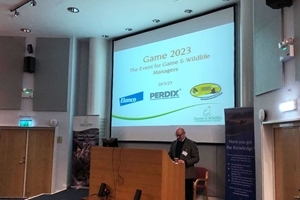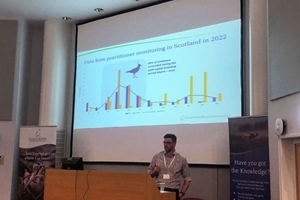By Amber Hopgood, Writer and Research Specialist
 Following an online hiatus, last week saw the return of the GWCT’s Game Conference for the first time since 2019. A highly anticipated event, delegates travelled to Shrewsbury from all corners of the United Kingdom to learn about the latest developments in game management research and policy work.
Following an online hiatus, last week saw the return of the GWCT’s Game Conference for the first time since 2019. A highly anticipated event, delegates travelled to Shrewsbury from all corners of the United Kingdom to learn about the latest developments in game management research and policy work.
A range of interested parties were present, with gamekeepers, shoot managers, farmers, vets and scientists alike gathering to hear from experts. Talks came from GWCT staff and scientists, as well as external speakers who between them gave updates and insight into both policy and recent scientific findings.
Following a warm welcome from the GWCT’s Head of Education Matt Goodall, our Head of GIS Dr Julie Ewald opened the conference. Julie summarised the National Gamebag Census – the Trust’s longest-running practitioner science project – detailing the large number of species monitored through the project and its far-reaching scientific impact, with results being used in work by the Joint Nature Conservation Committee and People’s Trust for Endangered Species, and published in a number of scientific journals.
Notably the project has produced unparalleled long-term trends in measures of gamebird, fox and crow numbers, and has highlighted that half as much hedgehog data is collected now compared to in the 1980s.
Dr Nick Hesford, one of the Trust’s Scottish Advisors, provided a useful summary of how the Advisory department have been utilising the EpiCollect5 app to collect a range of species, habitat and conservation action data directly from land managers, reminding people of Edward Deming’s famous quote: “Without data, you’re just another person with an opinion.”
In 2022 this amounted to over 1,000 wader nests being monitored in Scotland, which would not be possible without the efforts of those on the ground. Nick eloquently highlighted that with ever-increasing scrutiny on gamekeepers, farmers and other land managers, we all need to work to best practice standards and be ready to provide evidence of their benefits.
Continuing the theme of evidence-led land management and policy championed by the GWCT, Matt Goodall offered valuable insight and advice for those concerned about the new 12-week consultation Natural Resources Wales (NRW) has opened to collect views on gamebird releasing in Wales. This consultation is seeking opinions on proposed licensing from the 2024-25 season in Wales and has been on the horizon since November 2020.
Matt reassured attendees that NRW is not seeking to end releasing, but to better manage conflicting interests on the matter, having recognised that good game management has a net benefit for biodiversity. However, Matt also emphasised the Welsh Government’s negative position on game shooting and their commitment to banning snaring and cage use on farms, which would include rearing pens.
Matt encouraged everyone to keep working to best-practice standards, seek advice if needed, and encouraged responses to the NRW consultation. You can find out more and how to respond on our blog.
The first of the days’ external speakers, Spike Butcher, Operations Director of Aim to Sustain, gave an overview of the strategic partnership and what it aims to do, reminding everyone that some 1% of the British population shoots live quarry, and yet can have environmental benefit across much of the wider countryside. Spike highlighted that the key to the continued success of shooting is collaborating and engaging with each other, and the wider countryside sector.
 Ian Jones from the Hafren Veterinary Group and Tim Weston from the NGO spoke about the latest news and developments with avian influenza from a veterinary and a keepering perspective. Ian communicated that the H5N1 strain from 2021 is particularly deadly compared to others, and is the strain we are still predominantly dealing with.
Ian Jones from the Hafren Veterinary Group and Tim Weston from the NGO spoke about the latest news and developments with avian influenza from a veterinary and a keepering perspective. Ian communicated that the H5N1 strain from 2021 is particularly deadly compared to others, and is the strain we are still predominantly dealing with.
A single goose dropping has the potential to infect some 12,000 birds, and so Ian emphasised the need for best-practice biosecurity measures and awareness. He also shared that when case numbers were expected to fall the strain mutated and affected seabirds, decimating many coastal breeding colonies.
Tim echoed this, highlighting that H5N1 is now thought to be endemic in black-headed gull populations, which may act as an ongoing source of disease. He also stated that while the effect of avian influenza had varied across the UK, some shoots lost as many as 70% of their pheasants in the South West. Tim also stressed the importance of everyone doing what they can to mitigate the disease and keeping comprehensive records.
The GWCT’s Head of Lowland Game Research, Dr Rufus Sage, provided details of his important work studying how gamebirds disperse through the landscape and use habitats, and how this might interact with fox population numbers.
Over the next few years, this work involves organisations like the RSPB, Natural England, NRW, Defra and multiple universities, with Rufus giving insight into a notable BASC-funded project investigating gamebird activity on sites where they are not released.
Rufus also explained the challenges of researching these kinds of topics, highlighting that despite pheasant release numbers increasing ten-fold since 1961, GWCT and BTO data show that fox numbers haven’t changed in response, however numbers of red kites and brown hares often change on releasing sites.
He reminded attendees that it can be all too easy to jump to conclusions, but the GWCT will continue to focus on investigating these complex ecological relationships and make recommendations based on scientific data.
Remaining on this topic, those present heard from Nathan Williams, a PhD student of the GWCT and Bournemouth University, who is using genetic techniques to study fox populations in central southern England. Nathan spoke of how a typical rural area will have around 2-3 foxes per km2, compared to around 23 foxes per km2 estimated to be in Bournemouth.
The impact of fox predation is readily seen, with 40 pairs of curlew only managing to produce ten fledglings across three breeding seasons in the New Forest. Currently Nathan is investigating where predators occupying protected areas are coming from, and what food sources support them, and hopes to publish his results soon.
To close the conference, we heard from the GWCT’s Director of Advisory & Education, Dr Roger Draycott. Roger emphasised how important the Trust’s research-informed, evidence-led practice is to support sound, practical game and wildlife management in the countryside and to inform government and policymakers, something that is becoming increasingly vital.
He remarked on how successfully the Trust is harnessing the power of technology and practitioner science, and how it can help us do valuable research that would not be otherwise possible.
When discussing the challenges faced by the sector, Roger stressed that “there is growing recognition from our statutory bodies of the important role the private land management sector has in delivering positive outcomes for wildlife. If the government is to be successful in reaching its biodiversity recovery targets, it must focus on the wider countryside, with over 70% of the landscape looked after by farmers, gamekeepers and shoot managers.
Game managers have all the tools in the box to recover wildlife, and we need more Working Conservationists doing their bit to help convince government and the wider public that sustainable game management is a force for good for nature conservation.”
Roger closed the day by urging attendees to consider supporting the GWCT through membership to help us continue this vital work.